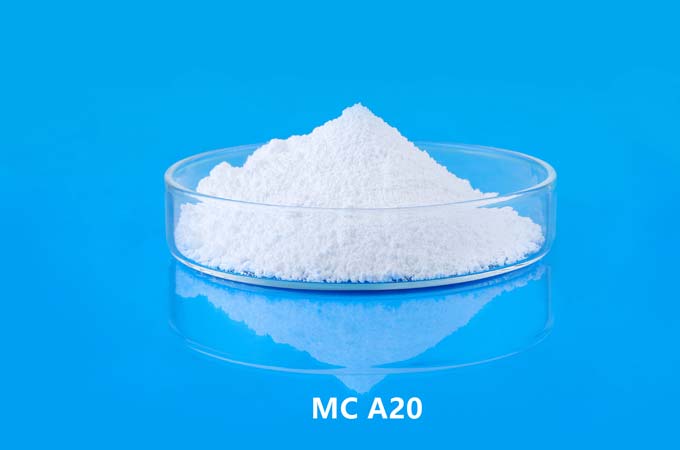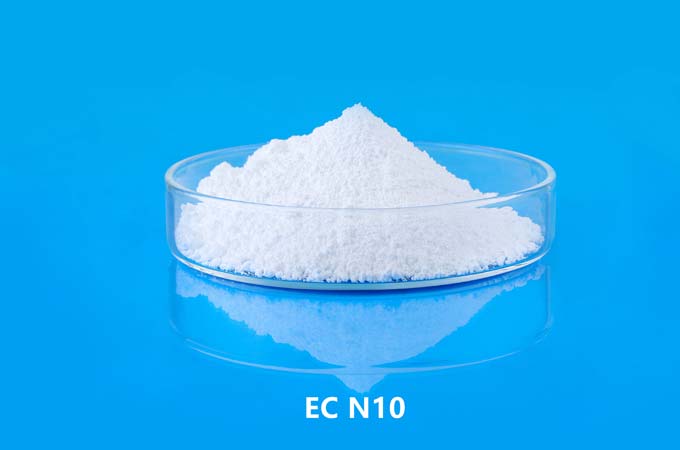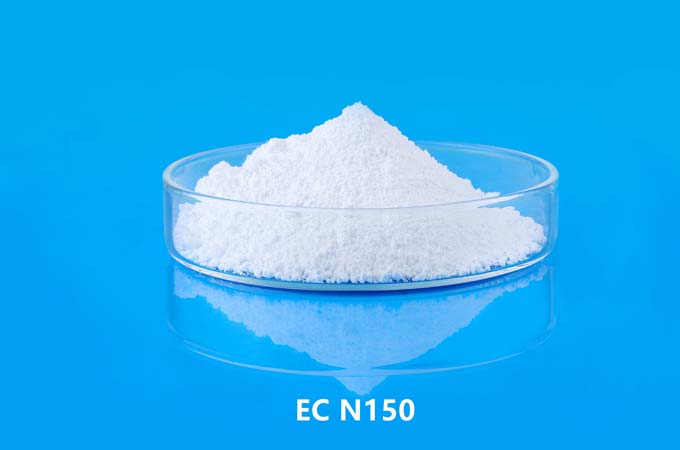Sodium carboxymethyl cellulose (CMC for short) is a derivative with an ether structure obtained by chemically modifying natural cellulose. Due to the poor water solubility of the acid form, the product is generally prepared as a sodium salt, sodium carboxymethylcellulose.
Sodium carboxymethyl cellulose is a representative anionic cellulose ether.
A hydrophilic group is introduced into the structural unit of cellulose, which has the functions of thickening, dispersing, suspending, emulsifying, binding, film-forming, protecting Colloid, moisture-proof and other excellent properties, widely used in detergents, ceramics, oil extraction, textiles, food, paper, tobacco, paint, medicine, cosmetics, building materials and other industrial sectors, is a very important water-soluble polymer, in industrial production most widely used. Sodium carboxymethyl cellulose is widely used in the ceramic industry as an additive. Its role in ceramic slurry and glaze is mainly to disperse, deagglomerate, suspend, attach and retain water;
1. Effect of Sodium Carboxymethyl Cellulose on Ceramic Slurry
Adding sodium carboxymethyl cellulose to the slurry can improve the dispersion suspension, fluidity, water retention, viscosity, bonding strength, deagglomeration and other properties of the ceramic slurry.
2. Dispersion Suspension Effect
Sodium carboxymethyl cellulose is a water-soluble long-chain polymer. When added to the slurry, the long molecular chain can form a unique network structure to support the gravity of the particles. Molecules or ions with sodium carboxymethylcellulose stretch out in the slurry like a belt and occupy a certain space, preventing particles from contacting each other and improving dimensional stability. And after dissociation, sodium carboxymethyl cellulose adsorbs negatively charged anionic groups and combines with particles, which increases the surface potential of the particles, and increases the electrostatic repulsion when the particles are close, thus playing the role of dispersion and suspension.
Experiments also prove that the slurry added with sodium carboxymethyl cellulose has a good dispersion and suspension effect. If the slurry without sodium carboxymethyl cellulose is placed for more than 48 hours, precipitation will occur, and the water will separate from the slurry, while the slurry with sodium carboxymethyl cellulose will not produce precipitation for a long time. Therefore, adding a dispersing suspending agent to the slurry can improve the dispersion stability of the slurry, which is beneficial to the uniformity and stability of the performance of the green body after molding, thereby improving the performance of the product.
3. Influence on Slurry Fluidity
Adding sodium carboxymethyl cellulose can improve the fluidity of the slurry. Studies have shown that with the increase in the amount of sodium carboxymethyl cellulose, the fluidity of the slurry first increases and then declines, and its content between 0.5% and 1.5% has a good effect on improving the fluidity of the mortar. At first, with the increase of sodium carboxymethyl cellulose, the fluidity of the mortar improved. On the one hand, it was due to the lubricating effect of sodium carboxymethyl cellulose between the particles, so that the mortar components flowed alone; on the other hand, It is due to the dispersed suspension effect and the ball effect caused by the air bubbles caused by the induction effect on the air. However, with the increase of sodium carboxymethyl cellulose, the fluidity of mortar will decrease because its viscosity hinders the flow of mortar. Therefore, sodium carboxymethyl cellulose has an optimal dosage range in improving the fluidity of mortar. The improved pulp added with sodium carboxymethyl cellulose has certain fluidity. If the fluidity is too high, the strength of the green body after forming is not enough, which will affect the demoulding and cleaning quality. If the fluidity is poor, the slurry transportation is inconvenient, and the green body after forming is also easily deformed. Therefore, controlling the fluidity of slurry is of great significance to meet production needs, improve production efficiency and product quality. The fluidity of the mortar will decrease because its viscosity hinders the flow of the mortar. Therefore, sodium carboxymethyl cellulose has an optimal dosage range in improving the fluidity of mortar. The improved pulp added with sodium carboxymethyl cellulose has certain fluidity. If the fluidity is too high, the strength of the green body after forming is not enough, which will affect the demoulding and cleaning quality. If the fluidity is poor, the slurry transportation is inconvenient, and the green body after forming is also easily deformed. Therefore, controlling the fluidity of slurry is of great significance to meet production needs, improve production efficiency and product quality. The fluidity of the mortar will decrease because its viscosity hinders the flow of the mortar. Therefore, sodium carboxymethyl cellulose has an optimal dosage range in improving the fluidity of mortar. The improved pulp added with sodium carboxymethyl cellulose has certain fluidity. If the fluidity is too high, the strength of the green body after forming is not enough, which will affect the demoulding and cleaning quality. If the fluidity is poor, the slurry transportation is inconvenient, and the green body after forming is also easily deformed. Therefore, controlling the fluidity of slurry is of great significance to meet production needs, improve production efficiency and product quality. Sodium carboxymethyl cellulose has an optimal dosage range in improving the fluidity of mortar. The improved pulp added with sodium carboxymethyl cellulose has certain fluidity. If the fluidity is too high, the strength of the green body after forming is not enough, which will affect the demoulding and cleaning quality. If the fluidity is poor, the slurry transportation is inconvenient, and the green body after forming is also easily deformed. Therefore, controlling the fluidity of slurry is of great significance to meet production needs, improve production efficiency and product quality. Sodium carboxymethyl cellulose has an optimal dosage range in improving the fluidity of mortar. The improved pulp added with sodium carboxymethyl cellulose has certain fluidity. If the fluidity is too high, the strength of the green body after forming is not enough, which will affect the demoulding and cleaning quality. If the fluidity is poor, the slurry transportation is inconvenient, and the green body after forming is also easily deformed. Therefore, controlling the fluidity of slurry is of great significance to meet production needs, improve production efficiency and product quality. If the fluidity is too high, the strength of the green body after forming is not enough, which will affect the demoulding and cleaning quality. If the fluidity is poor, the slurry transportation is inconvenient, and the green body after forming is also easily deformed. Therefore, controlling the fluidity of slurry is of great significance to meet production needs, improve production efficiency and product quality. If the fluidity is too high, the strength of the green body after forming is not enough, which will affect the demoulding and cleaning quality. If the fluidity is poor, the slurry transportation is inconvenient, and the green body after forming is also easily deformed. Therefore, controlling the fluidity of slurry is of great significance to meet production needs, improve production efficiency and product quality.
4. Influence on Water Retention of Slurry
After sodium carboxymethyl cellulose is dissolved in water, the hydroxyl group on the long chain and the oxygen atom on the ether bond combine with the water molecule to form a hydrogen bond, forming a hydration film, which makes the water lose its fluidity, and the free water is no longer "free". , so as to produce a thickening and water retention effect on the slurry. As the amount of sodium carboxymethyl cellulose increases, more free water in the slurry becomes associative water, and the water retention effect is better. The excellent water retention of the slurry can not only prevent the moisture in the slurry from diffusing into the plaster mold prematurely during the pouring process, ensure the uniform loss of water of the green body, but also avoid the excessive water diffusion process and reduce the strength of the green body, which is beneficial to the formation of uniform, dense It is of great significance to have a smooth, clean and defect-free grouting body. However, too much sodium carboxymethyl cellulose is added, and the water retention of the slurry is too high, so that the slurry loses water too slowly, resulting in too long pouring time, affecting the quality of the poured billet, and even causing cracks in the billet during the drying process.
5. Effect on Slurry Viscosity
Sodium carboxymethyl cellulose is a polymer molecule. When the amount added to the glaze slurry is small, the free activity space of its molecular chain is relatively large, and several adsorbable groups on the chain can be adsorbed by two or more solid particles to play a bridging role, so the viscosity is relatively large. When the amount of sodium carboxymethyl cellulose added is appropriate, the added polymer molecules can be completely absorbed by the solid particles, and almost all the interfaces of the solid particles are covered by the molecular chains of the polymer, resulting in steric stability (and electrostatic repulsion), So the viscosity is the least. After the excess is added, except for the polymer covering the surface of the solid particle, the excess polymer is distributed in the medium, and its long molecular chain will have a bridging effect with the solid particle with the adsorption layer. A polymer chain molecule can bridge a pair of particles, or several particles. With the increase of sodium carboxymethyl cellulose, the number of bridging particles in the glaze increases and the viscosity of the suspension increases. Flocculation occurs when the added polymer bridges all particles with an absorbent layer. The improvement of the viscosity of the slurry by sodium carboxymethyl cellulose ensures that the slurry has a low viscosity and good suspension stability, and at the same time ensures that the slurry does not flocculate. or a few particles. With the increase of sodium carboxymethyl cellulose, the number of bridging particles in the glaze increases and the viscosity of the suspension increases. Flocculation occurs when the added polymer bridges all particles with an absorbent layer. The improvement of the viscosity of the slurry by sodium carboxymethyl cellulose ensures that the slurry has a low viscosity and good suspension stability, and at the same time ensures that the slurry does not flocculate. or a few particles. With the increase of sodium carboxymethyl cellulose, the number of bridging particles in the glaze increases and the viscosity of the suspension increases. Flocculation occurs when the added polymer bridges all particles with an absorbent layer. The improvement of the viscosity of the slurry by sodium carboxymethyl cellulose ensures that the slurry has a low viscosity and good suspension stability, and at the same time ensures that the slurry does not flocculate.
6. Effect on Adhesion
The adhesion of sodium carboxymethyl cellulose in the slurry is characterized by polymer macromolecules or macromolecules relying on hydrogen bonds and van der Waals forces to form a firm network structure. When sodium carboxymethyl cellulose is added to the slurry, water will penetrate into the inside of the sodium carboxymethyl cellulose gum. The part with few hydrophilic groups swells with water, and the part with more hydrophilic groups swells and separates from the rubber block. Since the hydrophilic groups are not uniform during the production of sodium carboxymethyl cellulose, the dispersed particle size of the micelles is inconsistent. Hydration swelling occurs inside the micelles, while a layer of hydrates, the bound water layer, is bound on the outside. In the early stage of dissolution, the micelles are free in the colloid. Due to the asymmetry of size and shape, and the regular approach to each other under the action of van der Waals force, the bound water layer gradually forms a network structure. Since sodium carboxymethyl cellulose is fibrous, the formed network structure has a large volume and strong adhesion. Adding sodium carboxymethyl cellulose can improve the adhesion performance of the slurry. The slurry has poor bonding performance and low green body strength, and waste products are likely to be produced due to collisions and frictions during transportation, kiln entry, and drying; if the slurry has too strong bonding, it will result in strong water retention but poor fluidity , the quality of the product cannot be guaranteed during the casting and drying process, and it is easy to lead to the occurrence of waste products. Studies have shown that adding 0.2-0.5% sodium carboxymethyl cellulose to the green body can increase the adhesion of the green body, make it easy to shape, and increase the mechanical strength of the green body by 2 to 3 times.
In Conclusion
Sodium carboxymethyl cellulose, as a water-soluble polymer, makes the slurry have excellent dispersion suspension, fluidity, water retention, deagglomeration and other properties, and also improves the viscosity of the slurry, which has become an important in the ceramic industry. additive.
 English
English 日本語
日本語 français
français Deutsch
Deutsch Español
Español italiano
italiano русский
русский português
português العربية
العربية Türkçe
Türkçe Nederland
Nederland



